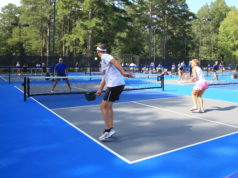By Page Love, MS, RDN, CSSD, LD
Everyone must hydrate adequately to beat the heat, but it can be difficult to discern what you need from your sports drinks and what you don’t. Many options have multiple unnecessary ingredients that aren’t scientifically proven to benefit your tennis play. When consumed in large quantities, these ingredients may also have adverse side effects and can increase your risk for heat illness, testing positive on doping tests and consuming higher-than-needed levels of unnecessary nutrients. Grab your Gatorade or Powerade and review the label next to my guidelines below to better understand the basics of a quality sport beverage.
Look for sports drinks with 10-14 grams of carbohydrates per 8 ounces (240 milliliters) to encourage rapid fluid replenishment. A small amount of carbohydrate provides a small amount of energy to delay fatigue during longer matches. Most research supports that up to an 8 percent carbohydrate content can be helpful to provide energy during play and improve fluid intake. Tennis players need carbs in longer matches to meet the energy intake recommendations of 30-60 grams of carbohydrate intake per hour in matches lasting 1-2.5 hours. To calculate the carbohydrate concentration of any beverage as a percentage, divide the amount of carbohydrate in one serving (in grams) by the amount of fluid in one serving (in milliliters), and then multiply by 100 (8 ounces equals 240 milliliters). For example: Gatorade has 14 grams carbohydrates (240 milliliters) x 100 = 5.83, or 6 percent carbohydrates.
Look for and review the types of carbohydrates in the beverage. Carbohydrates provide both energy for the brain and muscles, and sweetness can increase the palatability of the drink. But too much sweetness can reduce fluid absorption and lead to less hydration. Choose a beverage with several carbohydrate sources, like glucose, fructose and maltose, to ensure maximum fluid absorption.
Choose a sodium level of about 100-250 milligrams per 8 ounces. This will enhance the taste, increase absorption and better maintain hydration. One reason to replace this amount of sodium is that athletes average approximately 250 milligrams of sodium losses in a similar amount of sweat loss. The sodium content in most sport beverages makes you want to drink more to help maintain fluid balance, unlike water. You may also be at increased risk of hyponatremia if only large volumes of water are consumed alone without adequate sodium intake and this may be characterized as dizziness, headaches, confusion and even passing out.
Choose a beverage with key electrolyte content lost in sweat. Sodium, chloride, potassium, magnesium and calcium are the other key main electrolytes desired to be in a sport beverage. All of these electrolytes are essential for increasing the fluids back into the blood stream to prevent dehydration. Other nutrients added to a sport beverages have not been proven to be needed in significant amounts during activity.

Avoid vitamin and protein additives. Current research does not support the claim that there are immediate physiological benefits of adding any vitamins in any significant content to a sports drink. In fact, some B vitamins adversely affect the taste. Vitamin Water, often touted in the same category as a sport beverage, is not helpful during activity and is limited in electrolytes. Additionally, very little research supports the need for protein in a sport beverage. Significant protein content can slow down the gastric emptying of the beverage during activity and may cause gastrointestinal upset. Protein also changes the drink mouth feel and may feel heavy and gritty. If you’re consuming adequate protein in your meals throughout the day, there’s no need for more.
Avoid stimulant herbs and “energy” drinks. There have been no conclusive studies showing performance benefits from drinks containing herbs such as gingko biloba, ephedra, ginseng and guarana. These caffeine-like additives, studies suggest, can cause adverse dehydrating side effects, therefore increasing your risk of heat illness and muscle cramps.
Avoid caffeine in an on-court sport beverage. Caffeine has been shown to potentially cause dehydrating side effects and possibly increase the risk of heat illness. It was also on the IOC doping list as a stimulant agent until 2005. Caffeine, a diuretic, can act as a laxative, which could worsen dehydration. Moderate caffeine intake off the court, while adequately hydrating, has not shown to have negative heat illness consequences, but conservative approaches in using caffeine on the court are recommended.
Coconut-based waters are not sport beverages. These are, however, great off-court hydration alternative beverages. Coconut waters are very high in potassium, containing upward of 600-800 milligrams potassium per serving. The recommended amount of potassium to look for in a sport beverage should be between 25-100 milligrams per 8-ounce serving. The average endurance athlete loses between 100-200 milligrams of potassium in an hour of intense aerobic activity. Consuming more than this in a beverage can also make the beverage too concentrated and cause slow gastric emptying.
The Future of Hydration
Be on the lookout for a new nutrition label that will start appearing on labels of sport beverages in the U.S. this summer. The changes will provide information to help you better interpret sport beverage labels: potassium and calcium levels will now be listed in milligrams, so you will be able to determine if you are consuming significant amounts of these nutrients.
The latest in science know-how is to actually be able to calculate your personal sweat rate. Top professional players are utilizing labs like Heat Sport Sciences, which use sweat testing as a method to determine what you are actually losing in your sweat. The premise on which they operate is sweat losses can vary greatly amongst athletes of different size and sex. Because sweat losses vary from player to player and may increase in varying levels of heat and humidity, to actually test what your body is losing to determine what you should be drinking is the latest science. This company and others like it send sweat test kits that include a gauze pad you wear during practice or play that collect the minerals as you are sweating. The gauze is then packaged and sent to laboratories where they analyze the composition of your sweat and then determine appropriate amount of electrolytes that you should be targeting to take in your sport beverage during tennis play. Visit levelen.com for more information on this current technology.
What else does the future hold for us? Additional new technology to be aware of are hydration sensors that measure how much water and electrolytes you are losing. North Carolina State researchers announced in January they have developed a wearable impedance technology sensor that tracks hydration losses. The sensor is worn with an adhesive patch either on the chest or wrist as a watch and is lightweight. The watch will then transmit data from this low-cost sensor to other media that will relay how much liquid you are losing. Other hydration sensors include Nix, which utilizes hydrogels and a biometric sensor that can tell you how much and what you are losing in sweat composition. Visit nixbiosensors.com/biosensor to find out more about this technology.
_______
Page Love is a consultant for the ATP and WTA professional tennis tours and a member of USTA Sport Science Committee. For more information about sport nutrition for tennis, contact her at nutrifitga.com.




